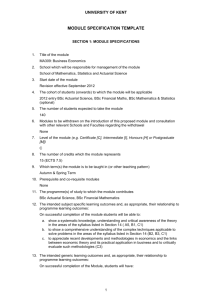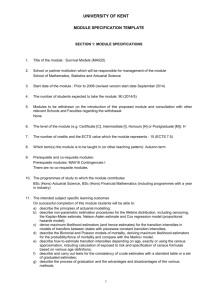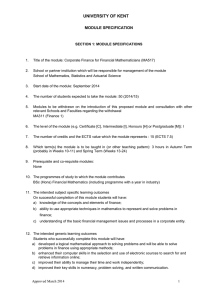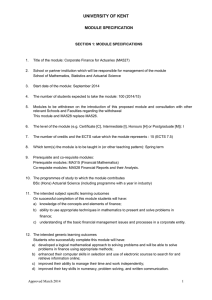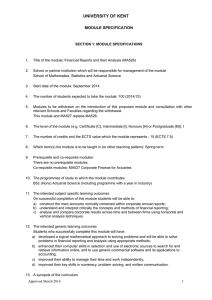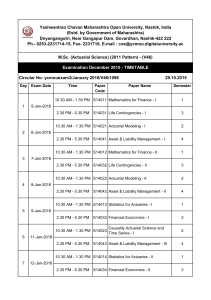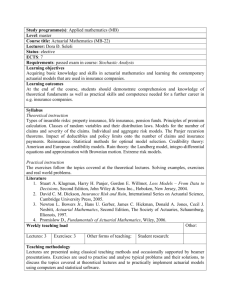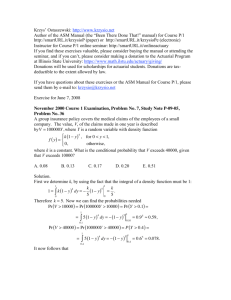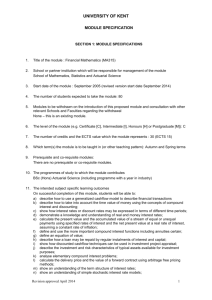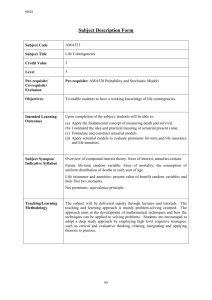MODULE SPECIFICATION
advertisement
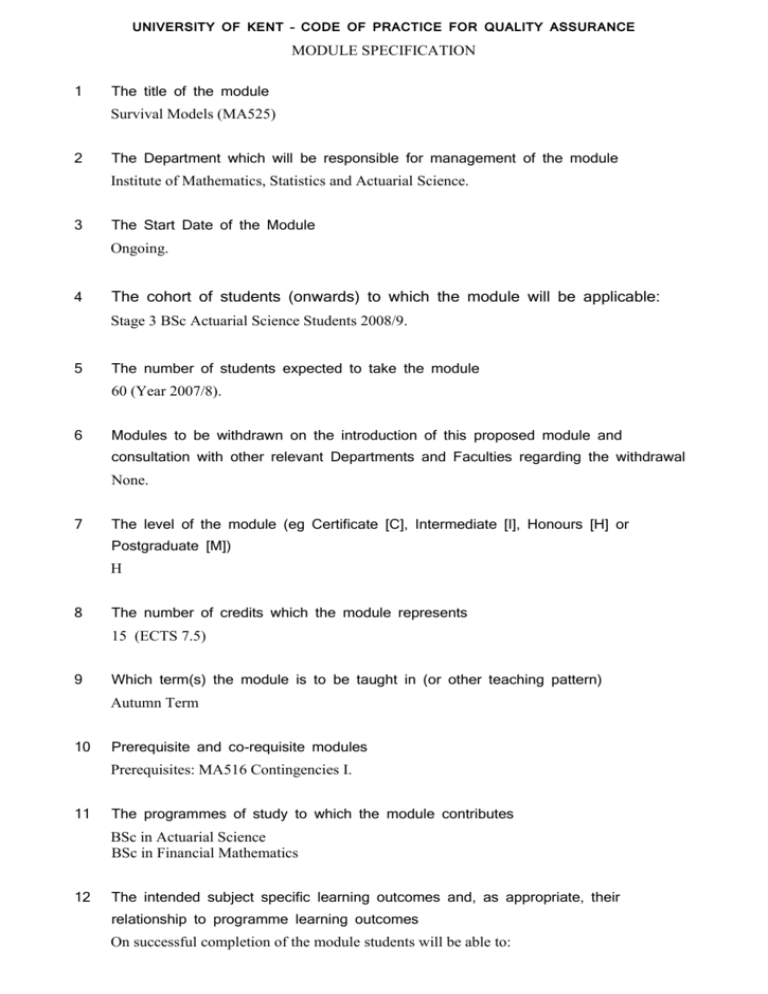
UNIVERSITY OF KENT – CODE OF PRACTICE FOR QUALITY ASSURANCE MODULE SPECIFICATION 1 The title of the module Survival Models (MA525) 2 The Department which will be responsible for management of the module Institute of Mathematics, Statistics and Actuarial Science. 3 The Start Date of the Module Ongoing. 4 The cohort of students (onwards) to which the module will be applicable: Stage 3 BSc Actuarial Science Students 2008/9. 5 The number of students expected to take the module 60 (Year 2007/8). 6 Modules to be withdrawn on the introduction of this proposed module and consultation with other relevant Departments and Faculties regarding the withdrawal None. 7 The level of the module (eg Certificate [C], Intermediate [I], Honours [H] or Postgraduate [M]) H 8 The number of credits which the module represents 15 (ECTS 7.5) 9 Which term(s) the module is to be taught in (or other teaching pattern) Autumn Term 10 Prerequisite and co-requisite modules Prerequisites: MA516 Contingencies I. 11 The programmes of study to which the module contributes BSc in Actuarial Science BSc in Financial Mathematics 12 The intended subject specific learning outcomes and, as appropriate, their relationship to programme learning outcomes On successful completion of the module students will be able to: UNIVERSITY OF KENT – CODE OF PRACTICE FOR QUALITY ASSURANCE a. describe the principles of actuarial modeling; (A6, A7, A8, B1, B3, B4, C3) b. describe non-parametric estimation procedures for the lifetime distribution, including censoring, the Kaplan-Meier estimate, Nelson-Aalen estimate and Cox regression model (proportional hazards model); (A2, A4, A6, A7, B1, B2, B3, B5, C1) c. derive maximum likelihood estimators (and hence estimates) for the transition intensities in models of transfers between states with piecewise constant transition intensities; (A2, A4, A6, A7, B1, B2, B3, B5, C1) d. describe the Binomial and Poisson models of mortality, deriving maximum likelihood estimators for the probability/force of mortality and compare with the Markov models; (A2, A4, A6, A7, B1, B2, B3, B4, B5, C1) e. describe how to estimate transition intensities depending on age, exactly or using the census approximation, including calculation of exposed to risk and specification of census formulae based on various age definitions; (A2, A4, A6, A7, A8, B1, B2, B3, B4, B5, C1, C3) f. describe and carry out tests for the consistency of crude estimates with a standard table or a set of graduated estimates; (A2, A4, A6, A7, A8, B1, B2, B3, B4, B5, C1, C3) g. describe the process of graduation and the advantages and disadvantages of the various methods. (A6, A8, B1, B4, C3) 13 The intended generic learning outcomes and, as appropriate, their relationship to programme learning outcomes On successful completion of the Module, students will have developed a logical mathematical approach to solving problems (B4, B5, D1, D3). They will have developed skills in oral and written communication (D2), time management and organisation (D7) and studying (D8). 14 A synopsis of the curriculum Lecture syllabus: 36 Lectures (Autumn Term) To follow objectives (i) and (vi) to (x) of the professional curriculum of the Faculty and Institute of Actuaries examination CT4. (See http://www.actuaries.org.uk/__data/assets/pdf_file/0007/29536/2007_CT4.pdf) This is a dynamic syllabus, changing regularly to reflect current practice. The 2008 syllabus is appended. 15 Indicative Reading List The students are recommended to purchase the study notes published by the Actuarial Education Company for Subject CT4 – Models. These are ordered through the department. 16 Learning and Teaching Methods, including the nature and number of contact hours and the total study hours which will be expected of students, and how these relate to achievement of the intended learning outcomes The module consists of: 36 lectures No. of contact hours: 36 Total study hours 150 The lectures will contain a number of worked and extended examples to aid understanding and emphasise the practical application of the theory. Continuous assessment sheets, which UNIVERSITY OF KENT – CODE OF PRACTICE FOR QUALITY ASSURANCE count towards the degree mark, are intended to reinforce the lecture material, encourage the student to read the study notes and to apply the concepts taught to practical problems. 17 Assessment methods and how these relate to testing achievement of the intended learning outcomes Assessment: The unit is assessed by examination (80%) and by continuous assessment (20%). Continuous Assessment: This will consist of two regular open-book written assessments which are completed by students outside of contact hours. These consist of questions and numerical problems requiring short and long answers and they tests the learning outcomes outlined in Section 12. Examination: A 3-hour written examination in the Summer term that will consist of questions and numerical problems requiring short and long answers and they test the learning outcomes as outlined in Section 12. 18 Implications for learning resources, including staff, library, IT and space This module has been in existence for several years. There should be minimal overall impact on the above resources. 19 A statement confirming that, As far as can be reasonably anticipated, the curriculum, learning and teaching methods and forms of assessment do not present any non-justifiable disadvantage to students with disabilities As far as can be reasonably anticipated, the curriculum, learning and teaching methods and forms of assessment do not present any non-justifiable disadvantage to students with disabilities. Statement by the Director of Learning and Teaching: "I confirm I have been consulted on the above module proposal and have given advice on the correct procedures and required content of module proposals" ................................................................ Director of Learning and Teaching .............................................. Date Statement by the Head of Department: "I confirm that the Department has approved the introduction of the module and will be responsible for its resourcing" ................................................................. Head of Department .............................................. Date
